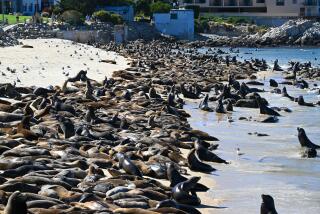Helping Foxes Outfox Eagles
- Share via
When biologists gaze upon the rare Santa Cruz Island fox, they see a delicate species found nowhere else in the world.
But when golden eagles perched high in the island’s crags look down upon the housecat-size animal, they see lunch.
That is why officials at Channel Islands National Park are summoning a group of eagle experts to the island late this month. Despite intense efforts to trap the island’s handful of remaining golden eagles, the raptors have killed five of the nine radio-collar-equipped foxes released into the wild from pens on Santa Cruz in late November.
“This is unfortunate news,” said park Supt. Russell Galipeau. “Although we’ve reduced the number of eagles from 29 to six or eight, that’s still a large enough number of birds to have an impact on the foxes.”
The experts will brainstorm new strategies for trapping the remaining eagles, Galipeau said.
The announcement of the foxes’ deaths last week is yet another dramatic illustration of how easily the environment on the rugged islands off the Ventura County coast can be thrown out of balance.
Feral pigs from early ranching operations roam the island, drawing golden eagles from the mainland that swoop down upon piglets. While they are at it, the eagles also prey upon the island fox.
Tracing the fox’s problems to the pigs, Park Service officials are about to launch a two-year program to eradicate the feral swine. Hunters will stalk them -- from choppers, trucks or on foot -- through the island’s rugged canyons.
The pigs also turn up the topsoil, destroying plant life known nowhere else in the world and allowing foreign plants to colonize and take over.
About 75 wild island foxes now roam Santa Cruz -- down from about 1,500 a decade ago. Unlike their captive-bred cousins that had been released, only a few of the wild foxes have fallen prey to golden eagles.
“We saw a very high survival rate,” Galipeau said. “About 80% of them survived in the last year.”
How they managed to escape the talons of the golden eagle while their cousins so readily succumbed is a mystery.
“We’re just going to have to keep asking questions,” Galipeau said.
Partly to fend off more golden eagles, the Park Service is reintroducing the American bald eagle, which abandoned the island years ago because DDT insecticide in its food supply made breeding impossible. The bald eagles feed mainly on fish and dead seals, not foxes.
The golden eagle has decimated the island fox colonies on the offshore park’s Santa Cruz, Santa Rosa and San Miguel islands, slashing the fox’s numbers by 95% in the last 10 years. Since 2000, the park and the Nature Conservancy have worked to stave off the foxes’ extinction with efforts to trap the golden eagles as well as with a captive-breeding program in which fox pups are sheltered from the birds.
The remaining golden eagles on the island have eluded capture for several years. Pursued in helicopters by rangers bearing nets, the eagles have dived into fog banks, scampered under trees and landed out of reach on sheer cliff sides.
Traps baited with pig carcasses and half-buried in the brush have been set in strategic places around the island. Such traps snared some of the birds that were captured and then transferred to a remote wilderness area in northeastern California.
None of them has returned, officials said.
More to Read
Sign up for Essential California
The most important California stories and recommendations in your inbox every morning.
You may occasionally receive promotional content from the Los Angeles Times.














